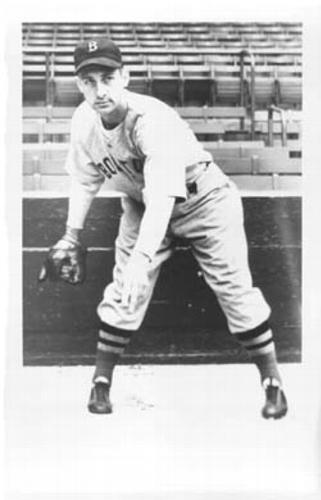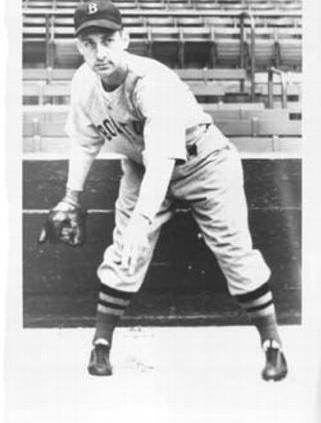June 10, 1938: Boston’s Bill LeFebvre homers in first, only at-bat of rookie season
 Bill LeFebvre came to bat just once in his debut year of 1938. He was a left-handed pitcher who had graduated from college two days earlier.
Bill LeFebvre came to bat just once in his debut year of 1938. He was a left-handed pitcher who had graduated from college two days earlier.
Back in 1935, Boston Red Sox GM Eddie Collins had seen talent in the young lefty and signed him to a contract, with the team agreeing to pay half his tuition during his final three years at the College of the Holy Cross in Worcester, Massachusetts.1
The day after his graduation, LeFebvre suited up in Boston. The day after that, he came to bat.
At the plate, LeFebvre saw all of one pitch. He homered, hitting the ball over Fenway Park’s left-field wall.
A week later, the Red Sox were in Chicago and manager Joe Cronin suggested that LeFebvre might be better off pitching for Boston’s Double-A2 affiliate in Minneapolis, getting regular work rather than sitting on the bullpen bench. So LeFebvre left the big-league team and joined the Minneapolis Millers.
Before LeFebvre’s debut game on Friday, June 10, the Red Sox were in second place in the American League, 3½ games behind the Cleveland Indians and tied with the New York Yankees for second place. They had just beaten the visiting Cleveland Indians in back-to-back day games on Wednesday, 7-6, and Thursday, 8-0 on a shutout thrown by Lefty Grove.3
The starting pitchers on June 10, in a game that drew around 12.000,4 were two right-handers, rookie Charlie Wagner for the Red Sox and Monty Stratton for the White Sox. Stratton had been 15-5 for the White Sox the year before, and he was 3-2 (2.15) up to this point in the 1938 season.5
June 10 was just the third start of Wagner’s big-league career.6 It did not go well. He got through the first inning fine, walking one but retiring the other three batters, and he was staked to a 1-0 lead in the bottom of the first when center fielder Doc Cramer led off with a first-pitch double to left-center and was singled home by left fielder Joe Vosmik, also swinging at the first pitch. Stratton got outs from the next three, and then dramatically turned the game in his favor when he came up to bat in the top of the second.
With a single to center, a base on balls, and a single on a sacrifice bunt back to Wagner, the White Sox loaded the bases with nobody out. Catcher Luke Sewell popped up to second base, but Stratton stepped into the batter’s box and hit a grand slam over the left-field wall.7 Wagner stayed in the game and struck out Boze Berger. But when Marv Owen doubled off him, manager Joe Cronin (who also played shortstop) called for a reliever.
Right-hander Jim Bagby took over. He walked the first batter, then gave up an RBI double to center fielder Mike Kreevich but was fortunate to see the second runner thrown out at home on a relay from left field. It was 5-1, White Sox.
Chicago added two more runs in the third, with Stratton contributing a single as the third of four consecutive hits that drove Bagby from the game. Lefty Lee Rogers relieved him.
In the fourth, Kreevich hit a solo home run off Rogers.
In the fifth, Stratton came to bat again with one out and a runner on third. Rogers balked and the score became 9-1. Stratton grounded out and there was no further damage. He then got the Red Sox out one, two, three.
Cronin made a number of moves to start the sixth. He summoned LeFebvre to pitch (as what the Chicago Tribune called a “surrender pitcher”8) and also replaced his catcher, third baseman, and center fielder, shuffling things around to give a bit of a rest to the regulars and an opportunity to a few bench players.
LeFebvre was not greeted kindly. Right fielder Hank Steinbacher singled. Kreevich was hit by a pitch. Rip Radcliff singled, driving in Steinbacher. LeFebvre then recorded his first out, but it was Gee Walker’s fly ball to center field that allowed Kreevich to tag and score. It was 11-1, White Sox. Second baseman Jackie Hayes hit into a 6-4-3 double play that closed out the inning.
LeFebvre didn’t allow a man on base in the seventh, but he gave up two more runs in the top of the eighth on a double by Owen and a homer to left-center by Kreevich, his second of the game. At this point, Chicago led 13-1.
New catcher Johnny Peacock was first to bat for Boston in the bottom of the eighth. He hit a fly ball hauled in by the shortstop. LeFebvre was up next. “Joe Cronin said, ‘Go up and hit, kid! Go up and hit!’” In one word, LeFebvre said what happened next: “Bang-o!”
He homered over the left-field wall. The ball struck something – perhaps one of the loudspeakers – and bounced back onto the field.9 It was a home run, struck on the first pitch thrown to LeFebvre in a big-league ballgame.
He later described the homer in more detail: “[T]he first ball Monty Stratton threw to me, I hit it over the left-field fence. I was a left-hand hitter; I swung a little late. … They used to announce the lineups and so forth. Loudspeakers. And it hit in the loudspeaker, which was an automatic home run. But I don’t know that. And the ball came back on the field. Mike Kreevich is playing center field, and he’s taking his time. When I hit the ball, I figured I’d hit the wall and I’d make a double anyway. When I got to second base – he knew it was a home run, but I didn’t – and I said to myself, ‘Christ, he’s not hustling,’ and I went sliding into third base. Bill McGowan was the umpire and he hollered, ‘Come on, kid. Come on in, you hit a home run.’ I didn’t even know it was a home run.”
LeFebvre’s solo home run made it 13-2. The next two batters grounded out to the first baseman and popped up foul, also to the first baseman.
Hayes homered off LeFebvre to lead off the top of the ninth. After a fly-ball out, Stratton singled (his third hit of the game), followed by two more White Sox singles that loaded the bases. Chicago got its 15th run on a productive groundout to second base.
Stratton set down Ben Chapman, Jimmie Foxx, and Joe Cronin in order to close out the 15-2 victory. The White Sox outhit Boston, 20 to 5, for 37 total bases. They hit four homers and five doubles. Foxx had homered in four consecutive prior games, but was held hitless in this one.
Stratton got the win. Wagner was charged with the loss. LeFebvre gave up six runs, but the game was already lost.
Still, LeFebvre had a home-run memory from the game that he would never forget. He ended up finishing out the season with Minneapolis. In 1939 he was 1-1 in five games for the Red Sox. In the 1943 and 1944 seasons combined, he was 4-4 for Washington, the only other stretch he spent in the majors.
After playing ball, LeFebvre went into teaching physical education and coaching sports. He worked for 25 years in Pawtucket, Rhode Island, while also doing some scouting for the Red Sox. When interviewed at age 90, he summed things up: “I wasn’t a great pitcher, you know. I was just an average guy.” Reminded of his .276 batting average in 87 at-bats (with just the one home run), he said, “That’s right. I should have played first base.”
Sources
In addition to the sources cited in the Notes, the author consulted Baseball-Reference.com and Retrosheet.org. The author interviewed Bill LeFebvre on June 19, 1997, and January 29, 2006. All quotations from LeFebvre that are not otherwise attributed come from these interviews.
https://www.baseball-reference.com/boxes/BOS/BOS193806100.shtml
https://www.retrosheet.org/boxesetc/1938/B06100BOS1938.htm
Photo credit: Bill LeFebvre, Trading Card Database.
Notes
1 Jack Barry was the baseball coach for the Holy Cross Crusaders and had granted LeFebvre a half-scholarship. Scout Hugh Duffy saw him pitch in the Cape Cod League and brought him, with a number of other players, to Fenway Park for a tryout. Red Sox GM Collins signed him to a contract, with the team also picking up the tab for most of his freshman year’s tuition, and half for the next three years. Many details that inform this game account come from LeFebvre’s SABR biography: Bill Nowlin, “Bill LeFebvre,” SABR.org.
2 Double A in the 1930s was the equivalent of today’s Triple A.
3 Grove shut out Chicago despite walking four and giving up nine base hits. All games at Fenway were day games in the1930s; its first night game was not played until June 13, 1947.
4 It was Ladies Day, with paid admission around 7,000 and another 5,000 “Fanettes” (as the Boston Globe dubbed them) at the game. Gerry Moore, “Sox Stumble, but Occasionally Save Face with a Laugh,” Boston Globe, June 11, 1938: 6. Moore also passed on a story from LeFebvre about another memorable at-bat from the preceding summer in which he both hit into a triple play and broke his right collarbone in a collision at first base.
5 Stratton’s pitching career was developing nicely; he was 15-9 in 1938, but in November he accidentally shot himself in the right thigh while rabbit hunting and never regained his form as a pitcher.
6 Wagner had beaten the St. Louis Browns, 6-3, on June 1. He had also relieved in five games, coming into the June 10 game with an ERA of 6.35.
7 The Chicago Daily News reported Stratton laughing afterward, saying. “I made up my mind to swing when I went up there, and he threw where I was swinging.” John P. Carmichael, “Showers Force Postponement of Sox Contest,” Chicago Daily News, June 11, 1938: 25.
8 Edward Burns, “White Sox Get 20 Hits; Crush Boston, 15 to 2,” Chicago Tribune, June 11, 1938: 17.
9 The Boston Globe reported that the ball actually struck the screen and bounced back onto the field of play. James C. O’Leary, “White Sox Bombard Yawkey Youngsters,” Boston Globe, June 11, 1938: 5.
Additional Stats
Chicago White Sox 15
Boston Red Sox 2
Fenway Park
Boston, MA
Box Score + PBP:
Corrections? Additions?
If you can help us improve this game story, contact us.


